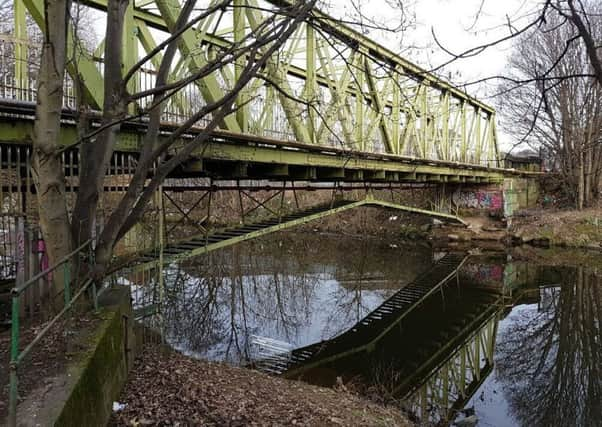Bridge works start to help reduce the risk of flooding in Leeds suburb


The platform under Gotts Bridge at Redcote Lane is not currently used and it has been known to restrict the flow of the River Aire by trapping debris during a flood.
It is situated downstream from where the majority of flood water escapes onto Kirkstall Road.
Advertisement
Hide AdAdvertisement
Hide AdThe bridge will not need to close during the work which is planned to start at the end of the month for around three weeks, following consultation with the bridge owner and local businesses.
The project, led by Leeds City Council in partnership with the Environment Agency, is one of the advanced works for the second phase of the Leeds Flood Alleviation Scheme.
Funded by the Government’s Department of Environment, Food and Rural Affairs, it is part of a package of measures of advanced works designed to mobilise defence construction quickly and efficiently to best protect the city, before the main works of the scheme are approved.
This work follows the completion of a new 730 metre flood defence wall and property level protection, such as flood gates and demountable barriers carried out to protect 88 businesses in the Stourton Industrial Estate.
Advertisement
Hide AdAdvertisement
Hide AdBack in December 2015, Leeds experienced significant and widespread flooding with some of the highest river levels ever recorded following Storm Eva. The flooding affected nearly 3,000 residential properties and nearly 700 commercial properties.
Leader of Leeds City Council Councillor Judith Blake said: “We are very pleased to see these advanced works carried out as part of the next phase of the Leeds Flood Alleviation Scheme. The Kirkstall Corridor was very badly hit during the Christmas floods of 2015, so seeing this work being undertaken is important for local residents and businesses to show progress is underway. Completing phase two in full is vital to offer the best possible level of flood protection, and we are now waiting to hear back from the government on our proposal which would allow work on the full programme to begin next year, which would offer further reassurance for everyone in Leeds.”
Adrian Gill, area flood risk manager from the Environment Agency, said: “Since Boxing Day 2015 we have worked closely with Leeds City Council and phase one of the Leeds Flood Alleviation Scheme was successfully completed in October 2017.
Advertisement
Hide AdAdvertisement
Hide Ad“The Environment Agency is continuing to work closely with Leeds City Council to develop a strong business case for the next phase of the scheme, which will help to ensure that Leeds continues to be a great place to live, work and do business.”
Harry Albazie, owner of Samsara Group, a businesses based in the area, said: “We are pleased to be assisting the council with the flood alleviation scheme and hope their contribution will improve any future flood risk and the local community.”
An outline business case for phase two of the scheme has been submitted to government, which outlines plans to reduce flood risk to the city upstream of the city centre, taking a catchment wide approach.
Phase two identifies measures further upstream including the Kirkstall corridor which was badly hit by the 2015 Christmas floods. It also looks at areas beyond the city boundary to further reduce the possibility of the river flooding in Leeds.
Advertisement
Hide AdAdvertisement
Hide AdThe phase two plans also have a strong focus on Natural Flood Management (NFM), with proposals to create new woodland areas which would significantly increase the canopy coverage in the River Aire catchment. It also proposes a water storage area to be created and developed, operated by control gates system meaning water can be held and then released back into the river when safe to do so. A third element would be the removal of existing obstructions along the river to help reduce water levels.
Aside from these measures, phase two would also see some new infrastructure measures installed including landscaping, terracing, embankments and walls, but due to the range of natural measures the height of any engineered defences would not need to be as high as they otherwise would be to offer the same standard of protection typically averaging 1.2 to 1.5 metres in height.
If approved by the government, proposals for the main works of phase two, created by Leeds City Council working with the Environment Agency would see work scheduled to begin in summer 2019.
In October last year, the £50 million phase one of the Leeds Flood Alleviation scheme was officially opened which now provides a 1 in 100 year standard of protection. Work involved the construction of moveable weirs at Crown Point and Knostrop, flood walls and the removal of a manmade island which separated the canal and river, known locally as Knostrop Cut. The weirs can be lowered when high river flows are expected, to help lower the river level.